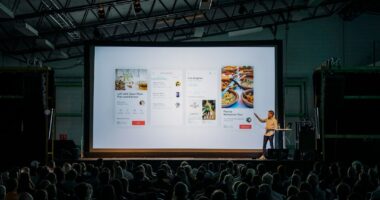The world of Non-Fungible Tokens (NFTs) has emerged as a revolutionary frontier in the digital landscape, particularly for graphic designers seeking to expand their creative horizons. NFTs are unique digital assets that represent ownership of a specific item or piece of content, often linked to art, music, or other forms of creative expression. Unlike cryptocurrencies such as Bitcoin or Ethereum, which are interchangeable and hold the same value, NFTs are distinct and cannot be exchanged on a one-to-one basis.
This uniqueness is what makes them particularly appealing to artists and designers, as they can create verifiable scarcity in a digital realm that has historically struggled with issues of reproduction and copyright. For graphic designers, understanding the mechanics of NFTs is crucial, as it opens up new avenues for monetization and audience engagement. As the NFT market continues to grow, it is essential for graphic designers to familiarize themselves with the platforms and marketplaces where these tokens are bought and sold.
Platforms like OpenSea, Rarible, and Foundation have become popular venues for artists to showcase their work and connect with collectors. Each platform has its own set of rules, fees, and community dynamics, which can significantly impact a designer’s success in this space. Moreover, the NFT ecosystem is not just about selling art; it encompasses a broader cultural movement that includes discussions around ownership, authenticity, and the future of digital creativity.
By immersing themselves in this environment, graphic designers can better position themselves to leverage their skills in ways that resonate with both collectors and fellow creators.
Key Takeaways
- NFTs are unique digital assets that can represent ownership of digital or physical items, and understanding the NFT space is crucial for graphic designers looking to enter this market.
- Graphic design plays a significant role in the visual aspect of NFTs, as it can enhance the appeal and value of the digital assets.
- Design considerations for NFTs include file formats, resolution, and aspect ratios to ensure the artwork is suitable for the blockchain and NFT platforms.
- Graphic designers can leverage their skills to create branding and identity for NFT projects, helping to establish a strong visual presence in the NFT space.
- User experience (UX) design is essential for NFT platforms to ensure a seamless and engaging experience for users interacting with NFTs and the blockchain technology.
- Graphic designers can collaborate with blockchain technology by creating visual elements for NFT platforms and exploring innovative ways to integrate design with the technology.
- Ethical and legal considerations are important for graphic designers in the NFT space, including copyright issues, licensing, and ensuring the authenticity of the digital assets.
The Impact of Graphic Design on NFTs: Exploring the Visual Aspect
Graphic design plays a pivotal role in the NFT space, as the visual appeal of a digital asset often determines its marketability and desirability. The aesthetic quality of an NFT can significantly influence its perceived value, making it imperative for designers to hone their craft and develop a distinctive style that stands out in a crowded marketplace. From vibrant illustrations to intricate animations, the visual elements of an NFT can evoke emotions and tell stories that resonate with potential buyers.
This connection between art and audience is crucial; a well-designed piece can capture attention and foster a sense of community among collectors who share similar tastes and interests. Furthermore, the integration of graphic design into NFTs extends beyond mere aesthetics; it also encompasses the conceptual framework behind the artwork. Designers are increasingly exploring innovative ways to incorporate interactivity and multimedia elements into their NFTs, creating immersive experiences that engage viewers on multiple levels.
For instance, some artists are experimenting with augmented reality (AR) or virtual reality (VR) components that allow collectors to experience their work in dynamic environments. This evolution of design not only enhances the value proposition of NFTs but also challenges traditional notions of what art can be in the digital age. As graphic designers navigate this new terrain, they must remain attuned to emerging trends and technologies that can elevate their work and redefine the boundaries of creativity.
Navigating the Technical Requirements: Design Considerations for NFTs

Creating NFTs involves a unique set of technical requirements that graphic designers must navigate to ensure their work is properly represented on blockchain platforms. The process typically begins with selecting a blockchain that supports NFTs, such as Ethereum or Tezos. Each blockchain has its own standards for creating tokens—Ethereum uses ERC-721 and ERC-1155 standards, while Tezos employs FA2—so understanding these specifications is essential for designers looking to mint their creations successfully.
Additionally, designers must consider file formats and sizes; most platforms accept formats like JPEG, PNG, GIF, or MP4, but each has its own limitations regarding resolution and file size. This technical knowledge is crucial for ensuring that the final product maintains its quality while adhering to platform guidelines. Moreover, designers must also be aware of the environmental implications associated with minting NFTs, particularly on energy-intensive blockchains like Ethereum.
The process of creating an NFT often requires significant computational power, leading to concerns about carbon footprints and sustainability. As awareness of these issues grows within the creative community, many designers are seeking eco-friendly alternatives or exploring ways to offset their environmental impact. This may involve choosing blockchains with lower energy consumption or participating in initiatives aimed at promoting sustainability within the NFT space.
By addressing these technical considerations thoughtfully, graphic designers can create impactful work while remaining conscious of their ecological footprint.
Branding and Identity in the NFT Space: Leveraging Graphic Design
In an increasingly competitive NFT marketplace, establishing a strong brand identity is paramount for graphic designers looking to differentiate themselves from the crowd. A cohesive visual identity not only helps artists communicate their unique style but also fosters recognition among collectors and enthusiasts. This branding extends beyond individual pieces of art; it encompasses everything from social media presence to website design and promotional materials.
By curating a consistent aesthetic across all platforms, designers can create a memorable experience for their audience that reinforces their artistic vision and values. Additionally, branding in the NFT space often involves storytelling—designers must articulate their creative journey and the concepts behind their work in a way that resonates with potential buyers. This narrative can be conveyed through various mediums, including artist statements, social media posts, or even video content that showcases the creative process.
By engaging collectors on a personal level and inviting them into their artistic world, designers can cultivate a loyal following that extends beyond individual transactions. In this way, graphic design serves not only as a tool for creating visually appealing NFTs but also as a means of building lasting relationships within the community.
The Role of User Experience (UX) Design in NFT Platforms
User experience (UX) design is an often-overlooked aspect of the NFT ecosystem that significantly impacts how collectors interact with digital assets. A well-designed platform should prioritize ease of navigation, intuitive interfaces, and seamless transactions to enhance user satisfaction. For graphic designers entering this space, understanding UX principles can provide valuable insights into how their work is presented and experienced by potential buyers.
A positive user experience can lead to increased engagement and higher sales, making it essential for designers to consider how their art fits within the broader context of platform usability. Moreover, UX design also plays a critical role in educating users about NFTs and blockchain technology. Many collectors may be unfamiliar with how to purchase or store NFTs securely, so platforms that incorporate educational resources or user-friendly guides can significantly enhance accessibility.
Graphic designers can contribute to this effort by creating visually engaging tutorials or infographics that demystify complex concepts related to NFTs. By prioritizing user experience in both design and education, graphic designers can help foster a more inclusive environment that encourages participation from diverse audiences.
Collaborating with Blockchain Technology: Graphic Designers’ Role in NFTs

As graphic designers delve deeper into the NFT space, collaboration with blockchain technology becomes increasingly important. Understanding how blockchain functions not only empowers designers to create more innovative work but also enables them to engage with developers and technologists effectively. This collaboration can lead to exciting projects that push the boundaries of traditional art forms—think generative art created through algorithms or interactive installations that respond to user input on the blockchain.
By embracing this intersection of art and technology, graphic designers can position themselves at the forefront of a rapidly evolving creative landscape. Furthermore, collaboration extends beyond technical aspects; it also encompasses partnerships with other artists and creators within the NFT community. Many successful projects arise from collective efforts where multiple talents come together to produce something greater than the sum of its parts.
Graphic designers can benefit from networking within this ecosystem by participating in collaborative exhibitions or joint ventures that amplify their reach and visibility. By fostering relationships with fellow creators and technologists alike, graphic designers can unlock new opportunities for growth while contributing to a vibrant community that celebrates innovation.
Ethical and Legal Considerations for Graphic Designers in the NFT Space
As graphic designers navigate the complexities of the NFT space, ethical and legal considerations become paramount in ensuring responsible practices within this burgeoning industry. Issues surrounding copyright infringement and intellectual property rights are particularly relevant; designers must be vigilant about protecting their work while also respecting the rights of others. The decentralized nature of blockchain technology complicates these matters further, as ownership can sometimes be ambiguous or misrepresented.
To mitigate these risks, graphic designers should familiarize themselves with copyright laws applicable to digital art and consider utilizing licensing agreements when minting their NFTs. Additionally, ethical considerations extend beyond legal compliance; they encompass broader questions about sustainability and inclusivity within the NFT space. As discussions around environmental impact gain traction, graphic designers have an opportunity to advocate for more sustainable practices within their work and communities.
This may involve choosing eco-friendly platforms or supporting initiatives aimed at reducing carbon footprints associated with blockchain transactions. By prioritizing ethical considerations alongside creative expression, graphic designers can contribute positively to an evolving industry while fostering trust among collectors and peers alike. In conclusion, the NFT space presents an exciting yet complex landscape for graphic designers eager to explore new avenues for creativity and expression.
By understanding the nuances of this environment—from technical requirements to branding strategies—designers can effectively navigate challenges while leveraging their unique skills to make meaningful contributions within this dynamic community. As they continue to engage with emerging technologies and ethical considerations, graphic designers will play an integral role in shaping the future of digital art in an increasingly interconnected world.
FAQs
What is NFT?
NFT stands for non-fungible token, which is a digital asset that represents ownership or proof of authenticity of a unique item or piece of content, such as artwork, videos, music, and more, using blockchain technology.
What is the role of graphic design in the NFT space?
Graphic design plays a crucial role in the NFT space as it is essential for creating visually appealing and unique digital artwork, which is then tokenized as NFTs. Designers are responsible for creating eye-catching and innovative digital assets that can be bought, sold, and traded as NFTs.
What do designers need to know about creating NFTs?
Designers need to understand the technical aspects of creating NFTs, including the use of blockchain technology, smart contracts, and digital wallets. They also need to be aware of the legal and copyright implications of creating and selling NFTs, as well as the potential environmental impact of blockchain technology.
How can graphic designers get involved in the NFT space?
Graphic designers can get involved in the NFT space by creating and selling their digital artwork as NFTs on various NFT marketplaces. They can also collaborate with blockchain developers and NFT platforms to explore new ways of integrating graphic design with blockchain technology.
What are some best practices for graphic designers in the NFT space?
Some best practices for graphic designers in the NFT space include creating high-quality and original digital artwork, understanding the market trends and demands, staying updated with the latest NFT platforms and technologies, and being mindful of the ethical and environmental considerations of NFT creation and trading.





